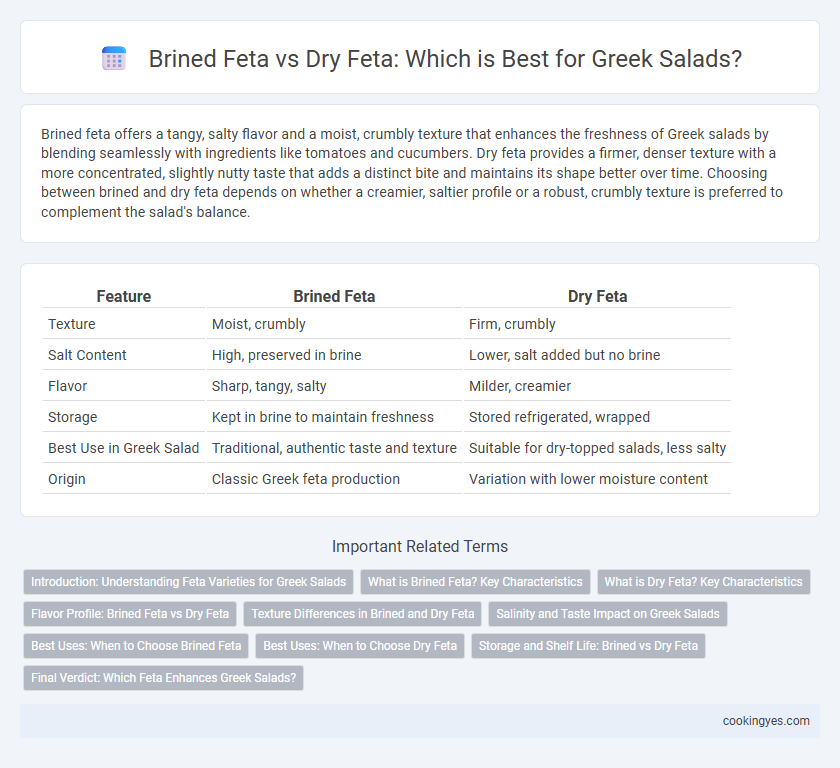Brined feta offers a tangy, salty flavor and a moist, crumbly texture that enhances the freshness of Greek salads by blending seamlessly with ingredients like tomatoes and cucumbers. Dry feta provides a firmer, denser texture with a more concentrated, slightly nutty taste that adds a distinct bite and maintains its shape better over time. Choosing between brined and dry feta depends on whether a creamier, saltier profile or a robust, crumbly texture is preferred to complement the salad's balance.
Table of Comparison
| Feature | Brined Feta | Dry Feta |
|---|---|---|
| Texture | Moist, crumbly | Firm, crumbly |
| Salt Content | High, preserved in brine | Lower, salt added but no brine |
| Flavor | Sharp, tangy, salty | Milder, creamier |
| Storage | Kept in brine to maintain freshness | Stored refrigerated, wrapped |
| Best Use in Greek Salad | Traditional, authentic taste and texture | Suitable for dry-topped salads, less salty |
| Origin | Classic Greek feta production | Variation with lower moisture content |
Introduction: Understanding Feta Varieties for Greek Salads
Brined feta preserves its characteristic tangy and salty flavor through immersion in a saltwater solution, making it ideal for Greek salads that benefit from a moist, creamy texture. Dry feta, aged longer and often stored without brine, offers a firmer consistency and concentrated flavor that adds a robust, crumbly element to the salad. Choosing between brined and dry feta impacts the salad's overall moisture balance and flavor intensity, influencing traditional Mediterranean taste authenticity.
What is Brined Feta? Key Characteristics
Brined feta is a traditional Greek cheese preserved in a salty, tangy whey or brine solution, which gives it a moist texture and sharp, salty flavor ideal for Greek salads. Its key characteristics include a crumbly yet creamy consistency, high moisture content, and a distinctive salty tang that balances fresh vegetables and olives. Unlike dry feta, brined feta's preservation in brine enhances shelf life and intensifies its signature taste, making it a staple in authentic Mediterranean cuisine.
What is Dry Feta? Key Characteristics
Dry feta is a type of Greek cheese that has been aged and drained of excess moisture, resulting in a crumbly texture and concentrated flavor ideal for salads. It has a firmer consistency compared to brined feta, with a tangy, slightly salty taste that enhances the freshness of Greek salads without adding extra liquid. Its low moisture content helps maintain the salad's crispness while providing a rich, creamy bite.
Flavor Profile: Brined Feta vs Dry Feta
Brined feta offers a tangy, salty flavor with a creamy yet crumbly texture, enhancing Greek salads by adding moisture and a pronounced savory note. Dry feta has a firmer texture and a milder, less salty taste, contributing a subtle richness without overpowering fresh ingredients. Choosing between brined and dry feta shapes the salad's overall balance of saltiness and creaminess, impacting its traditional Greek flavor authenticity.
Texture Differences in Brined and Dry Feta
Brined feta typically has a moist, creamy texture due to its preservation in salty whey or brine, which keeps it soft and slightly crumbly, ideal for Greek salads that benefit from a juicy, tangy bite. Dry feta, aged longer without brine, develops a firmer, crumbly texture with a more concentrated flavor, providing a denser, saltier profile that adds a robust contrast to fresh vegetables. The moisture content and aging process directly impact the texture, influencing how the feta integrates with the salad ingredients and enhances the overall mouthfeel.
Salinity and Taste Impact on Greek Salads
Brined feta offers a higher salinity that enhances the overall tartness and moisture of Greek salads, making the greens and vegetables taste fresher and more vibrant. Dry feta, with its crumbly texture and reduced salt content, imparts a milder flavor that allows the natural sweetness of tomatoes and cucumbers to stand out. Choosing between brined and dry feta influences the salad's balance, where brined feta intensifies tanginess and dry feta maintains subtlety in the dish.
Best Uses: When to Choose Brined Feta
Brined feta, preserved in a salty whey solution, offers a tangier, creamier texture that enhances Greek salads with authentic Mediterranean flavor. Its higher moisture content makes it ideal for salads where the dressing needs to cling to the cheese, ensuring balanced seasoning and a luscious bite. Choose brined feta for fresh, vibrant salads that benefit from extra juiciness and saltiness, complementing ingredients like tomatoes, cucumbers, and olives.
Best Uses: When to Choose Dry Feta
Dry feta offers a firmer texture and concentrated flavor that holds up well in Greek salads, especially when you want distinct, crumbly pieces that don't dissolve in the dressing. It's ideal for salads with bold ingredients like olives, cucumbers, and tomatoes, providing a salty tang without excess moisture that can wilt fresh vegetables. Choosing dry feta ensures the salad remains crisp and balanced, enhancing the overall taste and presentation.
Storage and Shelf Life: Brined vs Dry Feta
Brined feta, preserved in a saltwater solution, maintains moisture and freshness longer, typically lasting up to two months when refrigerated properly. Dry feta, stored without liquid, has a shorter shelf life of about one to two weeks and must be kept tightly wrapped to prevent dehydration and spoilage. Proper storage in airtight containers significantly extends the usability of both types in Greek salads, ensuring optimal flavor and texture.
Final Verdict: Which Feta Enhances Greek Salads?
Brined feta offers a tangy, moist texture that melds perfectly with the crisp vegetables in Greek salads, adding a refreshing burst of flavor. Dry feta provides a crumbly, more concentrated taste that creates a robust contrast, ideal for those seeking a sharper cheese presence. Choosing brined feta enhances overall balance and juiciness, making it the preferred option for authentic Greek salads.
Brined feta vs dry feta for Greek salads Infographic

 cookingyes.com
cookingyes.com